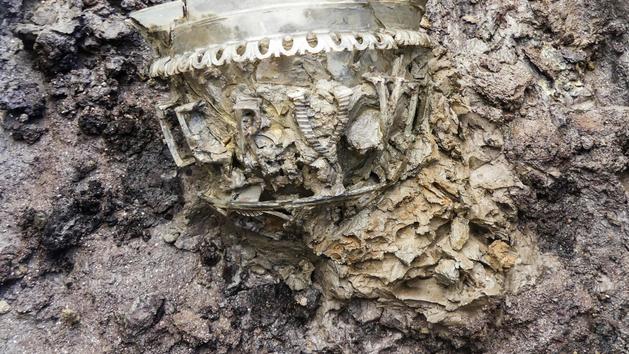An "
exceptional
"
vase
in worked glass from the end of the Roman period was unearthed in Autun (Saône-et-Loire) during the excavations of the 230 graves of an important necropolis, the Institute announced on Friday November 13. National Preventive Archaeological Research (Inrap).
Read also: Autun, the little Rome of Burgundy
This “
extremely rare
”
vase
, 12 cm high and 16 cm in diameter, is adorned with decorative sculpted motifs, enhanced with letters in relief forming the words “
Vivas feliciter
” (Vis in felicity), the archaeologists explained during a survey. press videoconference.
“
It is the first complete specimen discovered to date in Gaul
”, explained one of them, Michel Kasprzyk, adding that there are currently “
only ten complete diatret vases in the ancient world
”.
A diatretic vase is a type of reticulated glass vase from the late Roman period, around the 4th century, believed to be the culmination of Roman achievements in glass technique.
According to Michel Kasprzyk, the last intact copy was discovered in Taranes (North Macedonia) in the 1970s. “
Today the piece is kept away from light, under drastic security conditions, before being studied and meticulously restored,
”said Nicolas Tisserand, deputy excavation manager.
"
This is the first complete specimen discovered to date in Gaul,
" explained Michel Kasprzyk, archaeologist from Inrap.
- / AFP
Archaeologists have also found "
rare but rich
"
objects
, such as amber pins, a finely chiseled gold ring, and a gold ring set with garnet, enclosed in a sandstone sarcophagus.
Other stone burials yielded jet pins or rings, coins, a bronze belt buckle, and blue glass beads.
Coffins of lead "
large size
" contained fragments woven with gold thread fabric.
A smaller one contained a child's gold earrings.
"
These exceptional and extremely rare discoveries are interesting avenues for the study of the aristocracy of Autun, precociously Christianized at the beginning of the 4th century
", commented Michel Kasprzyk, considering that they "
will make it possible to illustrate and corroborate testimonies which were then known only by the texts
”.
The excavations at Inrap were carried out from June to mid-September, on a 1,300 m2 plot located in Autun, near the early Christian church of Saint Pierre l'Estrier, one of the oldest in Europe. .
Ancient burials of Gaul had been discovered on the site, which became a high place of medieval Christendom at the end of Antiquity.

